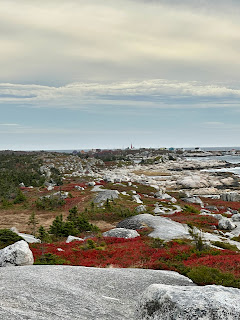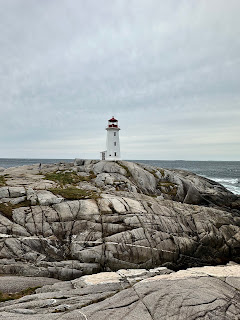Before I tell you anything about today, I must give you the answers to the trivia question if you haven’t already figured them out. The three sequences are: 1) Mars, Jupiter, Saturn, Uranus, 2) Pearl, Coral, Ruby, Sapphire (anniversaries), and 3) Home, Brain, Heart, Courage (things characters in the Wizard of Oz wanted). 100 points if you got them all right! I also met my new Brazilian friend Susanna and she air-dropped this photo she took of me with Chip the other day.
Today we docked in Halifax, Nova Scotia, the 2nd smallest province of Canada. For some reason I thought it was an island, but it isn’t; it’s actually a peninsula connected by a narrow strip of land, although the province does include some islands. As with the rest of this part of Canada, the French were the original settlers but for a century fought on and off with the British for control. The matter was finally settled in 1713 following the Peace of Utrecht which ended the War of the Spanish Succession and Britain gained the province. (Not to wander too far afield but when I think about it, it seems pretty strange that a war over which family would take possession of the Spanish throne would impact provinces in North America which was then the far side of the world. I think there’s a lesson that can be learned in terms of conflicts between seemingly unrelated belligerents in faraway places which can change the lives of people on the other side of the Earth.)
Anyway, back to Nova Scotia, after Britain prevailed the Acadian French who lived here were also expelled and many wound up in Louisiana. During our Revolutionary War many Loyalists, loyal to King George III, settled in Nova Scotia. In 1848 Nova Scotia became the first British colony to gain “responsible government,” meaning the provincial parliament had some autonomy and responsibility to the inhabitants. In 1867 Nova Scotia joined in confederation with New Brunswick, Québec and Ontario to become the Dominion of Canada. And there is a mini-history of this place.
Some interesting facts about Nova Scotia courtesy of my friend Kathie who lives here. Nova Scotia has 4700 miles of coastline, 156 light houses and light beacons and no point is further than 42 miles from the ocean. The bays and inlets which account for all the thousands of miles of coastline were formed by glaciers millions of years ago and along the shores the rocks have been worn smooth. One of the places Nova Scotia is known for is the Bay of Fundy which has the world’s largest tidal shift, 52 feet! Imagine that; the average tidal shift worldwide is only 3.3 feet. Time didn’t allow me to go to that Bay but I did make it to Peggy’s Cove, part of St. Margaret’s Bay which also has a significant tide.
When I tendered ashore this morning my friend Kathie, a trivia team member from my last trip, picked me up to take me on a tour. Kathie has lived in Halifax for 50 years after coming here from British Columbia. We drove out of the city past two large suspension bridges which connect two sides of Halifax Harbor, one of the largest and deepest ice-free natural harbors in the world. We quickly passed into mainly forest land on our way to Peggy’s Cove. There is an iconic lighthouse there which Kathie wanted me to see. I like stories and legends so I have to tell the story of how the place got its name. The less interesting version is that the cove is an inlet of St. Margaret’s Bay and Peggy is a diminutive of that name. The more romantic one is that a schooner was shipwrecked on Halibut Rock on a point near where the lighthouse now sits. The only survivor was a young woman named Margaret. A local fisherman rescued her and she eventually married him. People soon began calling the place Peggy’s Cove. A local author has written several novels memorializing the story.
There is a little village near the spit of land and a lighthouse around which an extensive walkway has been cleverly built so it doesn’t diminish the natural beauty and wildness of the rocks around the point; instead, it sort of blends in. There are warnings all around to be careful to not go off the walkway because large waves are not infrequent and can crash across the rocks and sweep people away. Today was a cloudy day and the wind was really blowing. That made it difficult to walk sometimes and it felt very cold despite the temperature being in the 50’s. My hat and gloves bought in Baie-Comeau the other day came in very handy.
 |
| The lighthouse at Peggy's Cove |
 |
| The point and lighthouse at Peggy's Cove. I think the walkway blends in well. |
 |
| Kathie and me - Do we look cold? |
As we drove into the Cove we passed a little white clapboard museum, which was closed, but next to it, carved into the face of one of the large rocks is a monument to the fishermen who live here. An artist named William deGarthe who was originally from Finland settled in Nova Scotia in the 1930’s and began painting. His works achieved some success. In the 1960’s he decided to try his hand at sculpture. After trying a variety of mediums, in the late 1970’s he began a 10 year project to sculpt a monument to the local fishermen. He enlisted the help of one of his students and they began carving a 100 foot long sculpture on a granite outcropping near his home in Peggy’s Cove. The work was 80% complete when deGarthe died in 1983. It depicts 32 fishermen, their wives and children and Peggy, the namesake of the Cove, enveloped in the arms of St. Elmo, the patron saint of fishermen.
 |
| deGarthe's house that's now a museum |
 |
| The Fishermen's Monument |
From Peggy’s Cove we drove along the shoreline to a monument commemorating the location of the crash of Swissair 111, a flight that went down here in 1998. Not quite on the scale of the people of Newfoundland who embraced people on planes forced to land on 9/11, the people here took in the family members of the people who perished on the plane when they came while the search was on for survivors (there were none) or personal items to remember their loved ones.
 |
| The shoreline near the Swissair memorial. It's a pretty rugged coast. |
As we drove along Kathie pointed out a local lobster business that started when she first came here 50 years ago and now sells lobsters all over the world. Lobster was so common and cheap that local farmers would feed it to their pigs. Times have changed. The shoreline was dotted with little cottages which city people own and spend the summers. After our drive we headed back to Halifax, the capital of Nova Scotia.
I don’t know what I expected, but Halifax was not at all as I thought it would be. The city has a population of close to 450,000 and there are quite a few multi-story buildings. The oldest part of the city is of course around the harbor. Overlooking that area is Citadel Hill, site of a fort first built back in 1749 by Edward Cornwallis, the governor of Nova Scotia. (He wasn’t the same Cornwallis we know in Virginia and who surrendered at Yorktown.) On our driving tour we passed the Commons, which was the area where over the years livestock could be pastured and soldiers could encamp. We drove by the Public Gardens which must be lovely in spring and summer. The downtown area is a mixture of very old buildings and a few modern glass and steel edifices. The old ones are now protected and the owners can make whatever changes they like inside but must preserve the exterior. The street running along the harbor is lined with restaurants, bars and quirky shops. There’s a promenade running along the waterside. Unfortunately since we tendered and we left around 3:30 PM I didn’t have an opportunity to do anything other than drive by. We were originally supposed to dock, but we were relegated to an anchorage because two mega-ships and one a little smaller but much bigger than ours took up all the docks.
 |
| The view from Citadel Hill. There used to be a ban on buildings blocking the view of the harbor but that's obviously gone by the wayside. |
 |
| Boo! Hiss! These guys took our dock space. |
It was a brief, but very interesting visit and it was so nice of Kathie to be my guide. It’s always nice to reconnect with friends and to see things from a local’s perspective. The weather cooperated except for the really blustery wind. This was our last stop in Canada. Now we’re on our way to the Big Apple. We’ve got a day at sea to rest up.







No comments:
Post a Comment